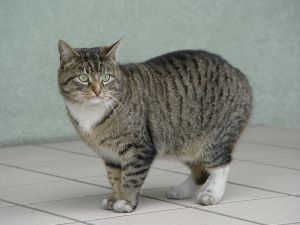



|
Manx Description
The Manx is known for its lack of tail and unique gait, affectionately called the Manx hop. The breed now includes the long-haired Manx, formerly known as the Cymric. It is recognized by its robust and round appearance; the Manx can be drawn entirely in circles. The head should be round, with round cheeks, medium in length with a well-developed muzzle and strong chin. Ears should appear round, wide at the base with rounded tips, they should be widely spaced and set slightly outward. There should be slight furnishings in the shorthair and full furnishings in the longhair. Eyes in the Manx should be large, round and full with eye and coat color matching.
The body is solidly muscular, compact and well-balanced. It is powerful without coarseness. The back should form a smooth arch from shoulders to rump and complete the round look. The Manx gene is dominant, this means kittens can have a full or short tail, a rise (rump risers) or no tail (called a rumpie). Some breeders have even recorded all tail lengths in a single litter. The Rumpie and Rump Risers, however, are the only variations permitted for show in the Manx category. There should be no bone or bump that stops the hand of the judge. The legs are heavily boned and set well apart; the hind legs are noticeably longer than the front with neat paws.
The short coat should be double and dense, with a feeling of being well-padded. It should be slightly hard and glossy in appearance. The long coat should be of medium length, dense and well-padded. It is to be soft and silky, with a healthy gloss. The Manx comes in about 30 colors and patterns.
Manx Temperament
The Manx is a playful cat with an incredibly high leap thanks to its powerful hindquarters. They are known for dog-like tendencies such as retrieving and burying toys, and get along with other pets; dogs in particular. Though they can vary in personality, the majority of Manx cats are family animals. Once they bond they are rarely happy if re-homed.
Manx Care
The shortened spine of the Manx can cause some spine related health issues. Super short spines may fail to provide nerve and muscle ending which can lead to bowel and bladder control problems and weak hindquarters. It is important that a potential owner ask if their kitten has shown any such signs or symptoms, as well as have them examined by an animal health professional.
Manx History
The history of the Manx, despite its age, is very sparse. They originated 100-300 years ago on the Isle of Man, off the coast of England. No one is certain when cats arrived on the Isle of Man, nor when the spontaneous mutation causing the loss of tail occurred. It is assumed that cats arrived on ships, as they often frequented the port, but there is no documentation of when their tails disappeared. The CFA has recognized the Manx since 1920, and they were the favored cats of King Edward VIII.
|